Derbyshire Blue Dun (Tutorial / SBS Tying Instructions)
Posted: Sun Sep 28, 2014 7:07 pm
Well, here is may second attempt at the Derby Shire style fly.
Derbyshire Blue Dun
Hook - Gamakatsu Traditional Series (Model S12S-1F Straight Eye Hook / Size 18)
Thread - Pearsall's Gossamer Silk (Primrose) - well waxed to give the thread an olive cast
Hackle - Very Small Hen Neck Hackle from the upper region of the neck (Grizzly Dyed Smoky Olive)
Wing - Small Bundle of Webby Fibers From a California Quail Wing Quill Feather (Natural Olive Dun)
Tail - Three Fibers of Wood Duck Flank (Natural)
Thorax - Mole Fur (blend of 75% Natural Dun & 25% Olive mole fur)

A view of the materials used to create the fly.
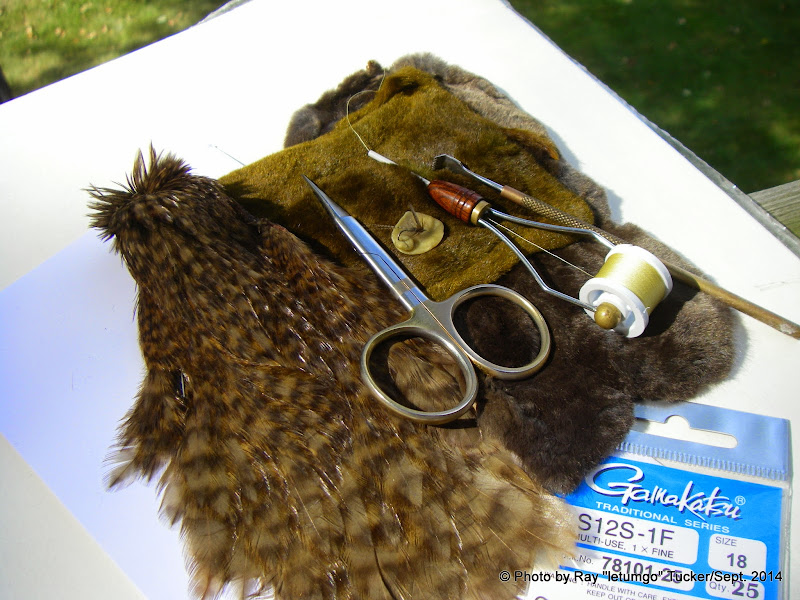
The dubbing used on the body of this fly was a blend of 75% Natural Dun Mole Fur/25% Mole Fur Dyed Olive. The block of wax in the aluminum foil was made by Eric (Smuggler) Kelly. I will be splitting up the block and sharing pieces of the block with the folks who participated in this swap. Thanks Eric!
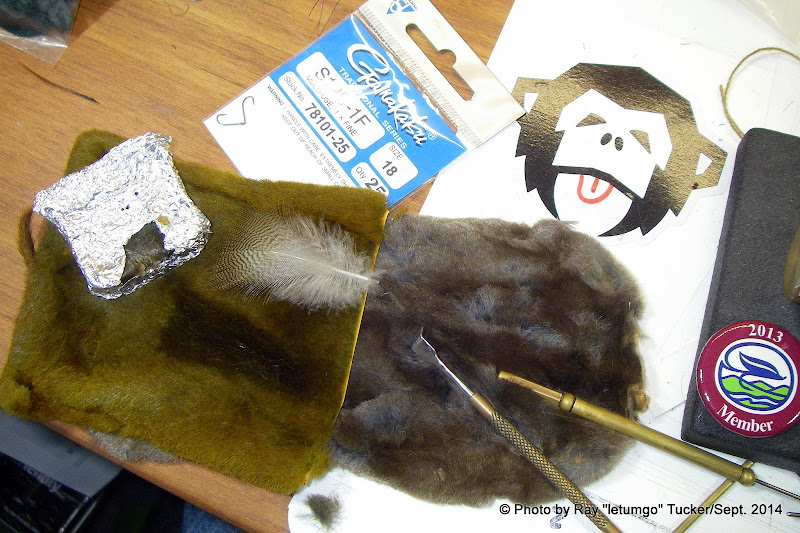
For those of you who like to peak under the wraps, here are a couple photos showing how I created my swap flies:
TYING INSTRUCTIONS/Step-by-Step:
1) Mount hook in vice.
2) Prepare tying thread by waxing the silk with the tying wax. This helps make the silk tacky and ensures it adheres to the hook, creating a durable fly.
3) Cast thread onto the hook and make three firm wraps. Leave the tag end on the thread, for now.
4) Prepare a small hen hackle feather by stripping the fluff off the base of the feather. Tye it onto the hook, by the stem, with the tip hanging out over the eye of the hook.
5) Prepare a small bundle of wing fibers (clipped from a wing feather and rolled into a small bundle). Tye the bundle onto the hook with two or three firm wraps. Trim off the silk tag/wing butts/feather steam.
6) Clip off three fibers of wood duck flank and tie them in as a tail. Try to have the nature curve of the feather facing upwards.
7) Wind the tying thread back to the bend of the hook and then apply a fine layer of dubbing to the waxed thread (touch dubbing ball to the waxed thread to "dust" the thread with dubbing fibers). Note that the dubbing should be very sparse.
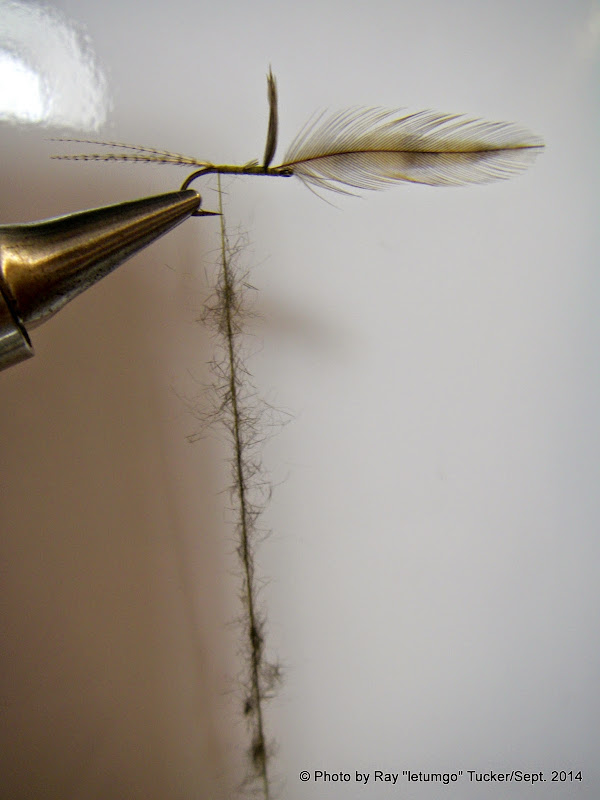
In the next photo, I have gone back and removed some of the excess dubbing. I only wanted a fine layer along the thread.
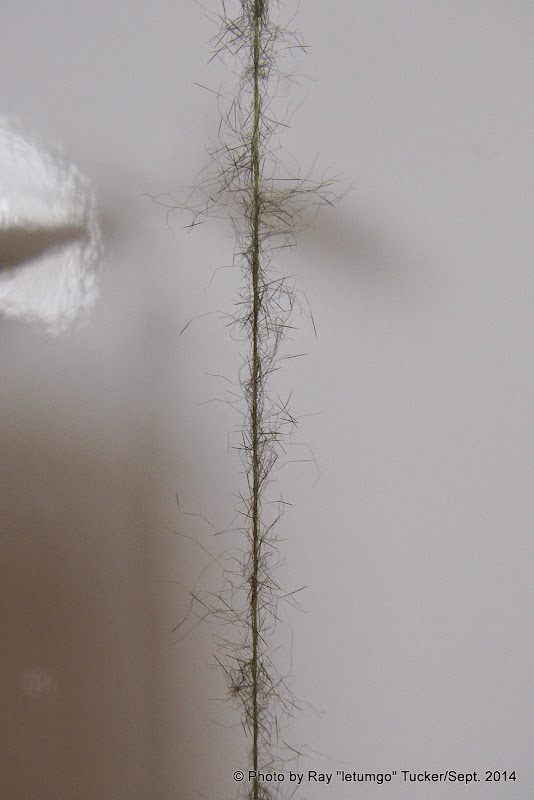
8) Wrap the tying thread forward, all the way to the eye of the hook, and then back to roughly the middle of the hook (just behind the wing). Wrapping in this way will create a slightly larger thorax region to the fly and will help position the thread to reinforcing the hackle.
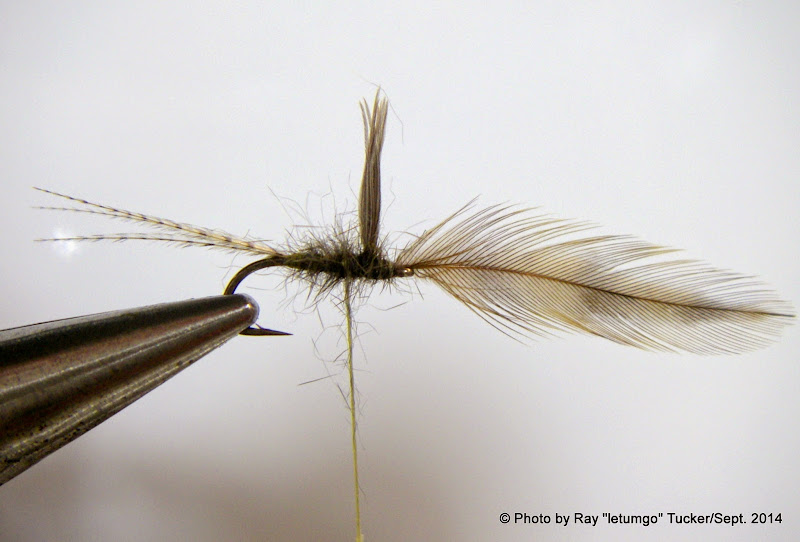
9) Grasp the tip of the feather in a pair of hackle pliers and then bend the feather until it is 90° to the hook shank. This step helps prepare the hackle for wrapping. Make two hackle wraps, next to the eye of the hook, then wrap backwards to the awaiting thread. Secure with one wrap, clip off the hackle tip. Keep firm tension on the tying thread was you wrap forward, thru the hackle fibers. The tread tension, and a wiggling-wrap, helps prevent trapping the hackle fibers.
10) Draw the hackle fibers back and make a three turn whip finish, to complete the fly.
11) Clip off the tying thread and you are done!
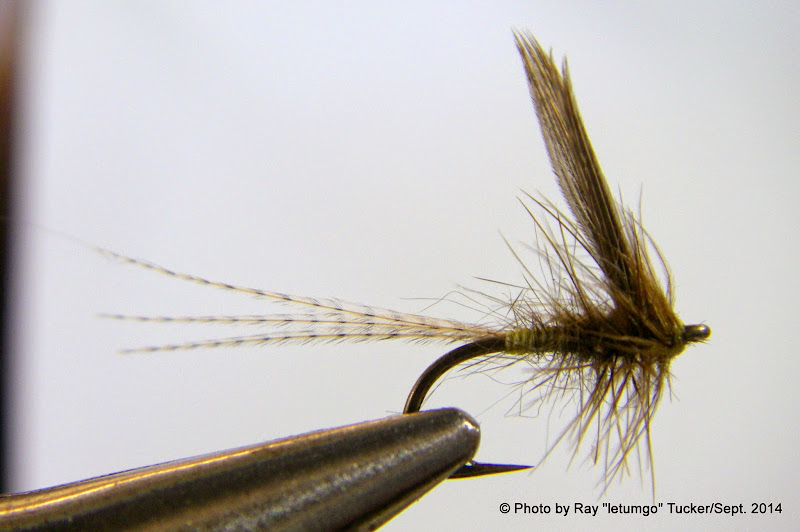
The shadow shows the impression the fly would make on the surface of the water (before it sinks...that is...)

EXPLANATION OF MATERIAL CHOICES:
I wanted to follow Chris's lead and take a moment to explain a few of my material choices, for the revised version of the fly.
Hank was kind enough to send me a copy of several pages from his copy of Rodger Wooley's book "Modern Trout Fly Dressings (Title page, plus pages 74, 75, 76, 77, 98, 99, 100 & 101). I carefully read the descriptions in these sections and realized I was trying to tye a fly, which on first appearance looked blue dun (grey), but on closer inspection had hints of olive. I then decided to change up the materials to capture these colors a bit more. I had a small piece of olive dyed mole fur, and a natural mole which was a steely dun color. I raked the hides and created a blend (75/25) of the two colors, favoring the dun color.
I then looked thru my natural gamebird skins, looking for a suitable winging material. I settled on wing quill feathers from a California Quail. The reason I chose this bird, is because the feathers have a natural grey-dun with an olive cast to it. This seemed perfect for the colors I was looking for.
Please note that I decided to stick with the Gamakatsu hook. I looked at several other hook types and sizes, but in the end chose this one since I liked the proportions. This is a tiny hook (size 18), but it still seems to create a nicely proportioned fly. I ended up with the overall profile that I was striving for.
Here is a close-up of the profile shown in the Skues book for comparison. I used woodduck tail fibers, because the pattern appeared to have a tail. It is my understanding that the Skues era flies had short whisky tail fibers. I have intentionally left them longer, as a personal style choice. I think the longer tail fibers will add movement and give the finished fly a more balanced look, at least to my eye.
Derbyshire Blue Dun
Hook - Gamakatsu Traditional Series (Model S12S-1F Straight Eye Hook / Size 18)
Thread - Pearsall's Gossamer Silk (Primrose) - well waxed to give the thread an olive cast
Hackle - Very Small Hen Neck Hackle from the upper region of the neck (Grizzly Dyed Smoky Olive)
Wing - Small Bundle of Webby Fibers From a California Quail Wing Quill Feather (Natural Olive Dun)
Tail - Three Fibers of Wood Duck Flank (Natural)
Thorax - Mole Fur (blend of 75% Natural Dun & 25% Olive mole fur)
A view of the materials used to create the fly.
The dubbing used on the body of this fly was a blend of 75% Natural Dun Mole Fur/25% Mole Fur Dyed Olive. The block of wax in the aluminum foil was made by Eric (Smuggler) Kelly. I will be splitting up the block and sharing pieces of the block with the folks who participated in this swap. Thanks Eric!
For those of you who like to peak under the wraps, here are a couple photos showing how I created my swap flies:
TYING INSTRUCTIONS/Step-by-Step:
1) Mount hook in vice.
2) Prepare tying thread by waxing the silk with the tying wax. This helps make the silk tacky and ensures it adheres to the hook, creating a durable fly.
3) Cast thread onto the hook and make three firm wraps. Leave the tag end on the thread, for now.
4) Prepare a small hen hackle feather by stripping the fluff off the base of the feather. Tye it onto the hook, by the stem, with the tip hanging out over the eye of the hook.
5) Prepare a small bundle of wing fibers (clipped from a wing feather and rolled into a small bundle). Tye the bundle onto the hook with two or three firm wraps. Trim off the silk tag/wing butts/feather steam.
6) Clip off three fibers of wood duck flank and tie them in as a tail. Try to have the nature curve of the feather facing upwards.
7) Wind the tying thread back to the bend of the hook and then apply a fine layer of dubbing to the waxed thread (touch dubbing ball to the waxed thread to "dust" the thread with dubbing fibers). Note that the dubbing should be very sparse.
In the next photo, I have gone back and removed some of the excess dubbing. I only wanted a fine layer along the thread.
8) Wrap the tying thread forward, all the way to the eye of the hook, and then back to roughly the middle of the hook (just behind the wing). Wrapping in this way will create a slightly larger thorax region to the fly and will help position the thread to reinforcing the hackle.
9) Grasp the tip of the feather in a pair of hackle pliers and then bend the feather until it is 90° to the hook shank. This step helps prepare the hackle for wrapping. Make two hackle wraps, next to the eye of the hook, then wrap backwards to the awaiting thread. Secure with one wrap, clip off the hackle tip. Keep firm tension on the tying thread was you wrap forward, thru the hackle fibers. The tread tension, and a wiggling-wrap, helps prevent trapping the hackle fibers.
10) Draw the hackle fibers back and make a three turn whip finish, to complete the fly.
11) Clip off the tying thread and you are done!
The shadow shows the impression the fly would make on the surface of the water (before it sinks...that is...)
EXPLANATION OF MATERIAL CHOICES:
I wanted to follow Chris's lead and take a moment to explain a few of my material choices, for the revised version of the fly.
Hank was kind enough to send me a copy of several pages from his copy of Rodger Wooley's book "Modern Trout Fly Dressings (Title page, plus pages 74, 75, 76, 77, 98, 99, 100 & 101). I carefully read the descriptions in these sections and realized I was trying to tye a fly, which on first appearance looked blue dun (grey), but on closer inspection had hints of olive. I then decided to change up the materials to capture these colors a bit more. I had a small piece of olive dyed mole fur, and a natural mole which was a steely dun color. I raked the hides and created a blend (75/25) of the two colors, favoring the dun color.
I then looked thru my natural gamebird skins, looking for a suitable winging material. I settled on wing quill feathers from a California Quail. The reason I chose this bird, is because the feathers have a natural grey-dun with an olive cast to it. This seemed perfect for the colors I was looking for.
Please note that I decided to stick with the Gamakatsu hook. I looked at several other hook types and sizes, but in the end chose this one since I liked the proportions. This is a tiny hook (size 18), but it still seems to create a nicely proportioned fly. I ended up with the overall profile that I was striving for.
Here is a close-up of the profile shown in the Skues book for comparison. I used woodduck tail fibers, because the pattern appeared to have a tail. It is my understanding that the Skues era flies had short whisky tail fibers. I have intentionally left them longer, as a personal style choice. I think the longer tail fibers will add movement and give the finished fly a more balanced look, at least to my eye.